Male Vs. Female Cannabis: How To Identify The Sex Of Your Plant
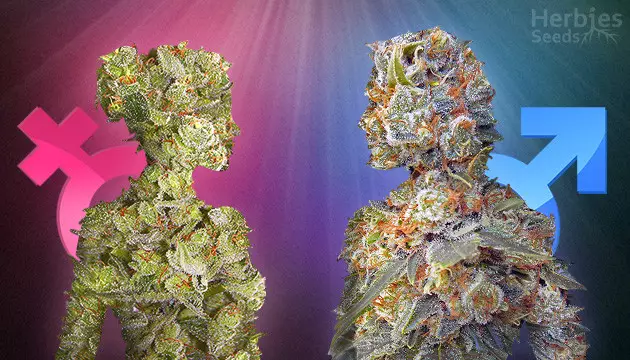
As much as we love cannabis in all its entirety, most growers would prefer having female weed plants over male ones in their garden at any given time. That’s because female cannabis has some great advantages for growers and smokers alike (not to diminish the value of male weed plants, which are essential for breeding purposes). In regular cannabis seeds, the split between the two sexes comes close to 50%/50%. So, if you’re looking to grow female plants only, or even both types together, knowing the differences between male and female cannabis plants and how to sex them on time is essential. Don’t let the success of your harvest rely on pure chance – learn the crucial skill of sexing weed in this article.
Disclaimer: Cannabis cultivation, possession, and use must comply with local laws. This content is intended for readers in regions where cannabis cultivation and use is legally permitted. Please check your local laws before purchasing or germinating cannabis seeds.
Female Cannabis Plants
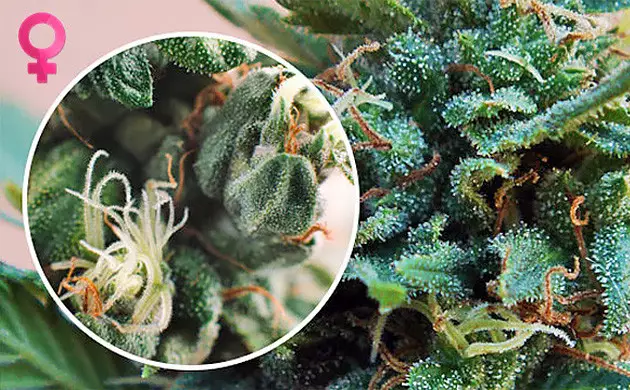
If you’re now wondering what makes female weed plants so much more preferred than their male counterparts, the answer is pretty simple: the potent, resinous buds we love to smoke so much are a product of female cannabis plants alone. These females produce the large, unpollinated flowers that secrete resin, which are trimmed down to rounded buds, ready to be smoked.
Therefore, all consumer-growers want female plants. Historically, marijuana cultivators have simply planted twice as many seeds, hoping that half the harvest will be female, but this practice was very costly in large harvest operations. These days, the majority of growers use feminized seeds that carry only female genetics and produce only female plants. Modern breeders have perfected this technique and have a nearly 100% success rate, thus streamlining the growing space, time, and cost.
What Does A Female Weed Plant Look Like?
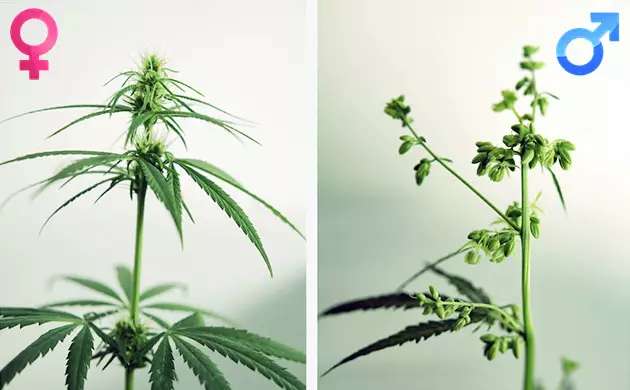
Appearance-wise, female cannabis plants also differ from their male counterparts. Besides the bushier structure, the differences continue with the leaves. How many leaves does a female pot plant have? Generally, female plants have many more leaves than do males. They also can have as many as 13 leaflets per leaf when fully mature, depending on the growing conditions and specific cannabis strain. At the top of the female plant, leaves are fewer as the buds and flowers develop. Aside from this, what makes the most difference is female cannabis plants’ reproductive organs.
In the next section, we’re going to break down the most important parts of the reproductive system of a female cannabis plant, what their functions are, and what they look like.
Parts Of A Female Cannabis Plant – What Are Sinsemilla, Pistils, And Calyx?
Sinsemilla, which are large seedless flowers with sticky resin, are the buds female plants grow if they are not pollinated by males. Sinsemilla is exactly what is harvested to smoke and produce various cannabis products. If female plants get pollinated, they put their energy into developing seeds instead of cannabinoid-rich resin. In fact, seeded buds can also be smoked, but they are much harsher tasting and of lower quality.

The bract is the part of the female plant that houses the female plant’s reproductive parts. One of the first signs of a bract is the tiny leaves that appear. Bracts are shaped like teardrops and contain numerous resin glands.
The pistil houses the flower’s reproductive parts, including the female plant’s characteristic hair-like strands called stigmas, which collect pollen from male plants. Stigmas begin forming as white, wispy structures, then turn red or brown as the plant matures. While the stigmas are important to reproduction, they don’t add any value to the cannabis flower’s taste or potency.
The calyx is the part of the flower that forms first, and eventually becomes the base of the bud holding its pistil and stigmas. Glands called trichomes reside in the calyx as well as the leaves and stems, and these glands secrete the resin seen on cannabis buds. The resin, which protects the plants from weather and predators, is found mostly in the calyx.
Cannabis resin contains aromatic oils called terpenes, which give cannabis its characteristic aroma. It also contains naturally occurring cannabinoids such as CBD and THC. Check out our collection of high-THC strains to find the strongest seeds for your next grow.
Now that you know the main parts of a female cannabis plant, how can you tell whether a female plant has been pollinated? In this case, the bracts will be larger. The white stigmas will turn red or brown after the plant is pollinated, so their color is also an indicator. If you peel back a bract with a pair of tweezers, you can look inside. If it has a seed, the plant has been pollinated.
Male Cannabis Plants

When it comes to male cannabis plants in the garden, they are sturdier and thicker. They also have fewer leaves and a much thicker stalk, necessary to support the weight at the plant’s full height, as male plants grow taller than females.
Since male plants take up quite a bit of growing space and use precious growing resources, they must be promptly identified and removed before they have a chance to pollinate the female plants. A single male plant can pollinate the whole garden of female cannabis plants and destroy the long-awaited harvest. These days, male plants are only introduced to pollinate female plants with the goal of collecting seeds or breeding new strains.
Pollen Sacs – What Do They Look Like?
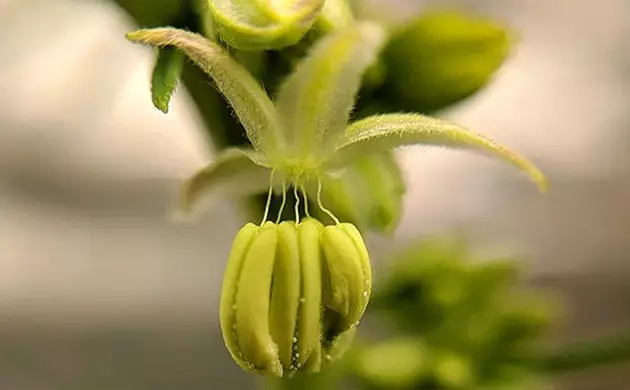
Pollen sacs are the main male reproductive organ of cannabis plants. What do pollen sacs look like? These tiny balls that form in the joints of the branches can be hard to spot in baby male plants. When the sacs mature, they break open to spread pollen. Generally, male plants release pollen in the first 3 weeks of the flowering phase. Male plants therefore need to be closely monitored after pollen sacs form so that growers can separate these plants before they can pollinate the females, if that’s unwanted.
Identifying Weed Sex
When growing cannabis from regular seeds, both male and female plants will likely be present in the garden. Until the point when the plants reveal their sex, growers will have to cultivate all of them. Below, we’ll explain when and how cannabis reveals its sex, and what signs to look out for to identify and eliminate any male plants early on.
How Do Cannabis Plants Reveal Their Sex?

Some strains show signs earlier than others, but most plants don’t express their sex until they’re well into the growing cycle. However, males generally reveal themselves earlier than female plants. For pot plants grown outdoors, males can show their sex 3 weeks before a female plant, while for cannabis grown indoors, male plants will generally reveal their sex 7 to 10 days before the female marijuana plant.
Experienced growers can learn to identify male and female plants early on to ensure a successful crop. About 4 weeks into the growth cycle, pre-flowers appear. Both types of plants form these early bulbs in their nodes, where the leaves and branches extend from the main stalk of the plant. After 6 weeks, the pre-flowers are well-formed and easier to find to determine the sex of the plant. The flowers are still small, and many growers use a small magnifying glass called a jeweler’s loop to look at the pre-flower formations up close.
In the early stages, both types of pre-flowers look very similar, which makes identification between male and female plants quite challenging. Growers examine the plant nodes to look for either sac or bract formations. The formation of small sacs in the node indicates a male plant. These sacs mature and spread pollen. Females will eventually develop long, wispy hairs that male plants do not have. All in all, a female plant will have two bracts and long tendrils that mature, and will produce hairy stigmas that catch pollen.
Can A Female Plant Turn Male?
Although there’s no way to tell if a cannabis seed is male or female, the sex of the cannabis plant is decided even before germination, and females therefore cannot turn into males and vice versa (although researchers are looking into this possibility).
If a male plant’s pollen lands on a female’s flower (bud), the female plant will produce seeds. However, it is still a female plant. On the other hand, if there are no male cannabis plants to pollinate the female plants, there’s a possibility that the female weed plants will turn into hermaphrodites. What is this phenomenon? Let’s examine this next.
Hermaphrodite Cannabis Plants – What Are They?
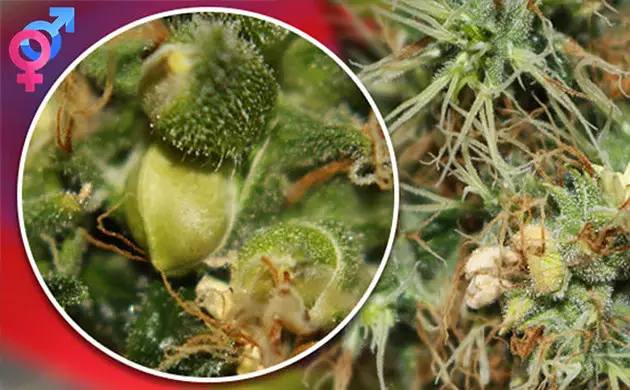
Sometimes, due to either stress or genetics, female cannabis plants can develop both male and female sex organs, meaning the bush grows buds as well as pollen sacs and turns into a hermaphrodite cannabis plants. These plants produce pollen and can pollinate both themselves and the other cannabis plants around them. Self-pollination is still pollination, and it means that the seedless sinsemilla, which we smoke, will not form.
Plant genetics play a big role in this phenomenon. They can determine whether a hermaphroditic plant will form, because such genes are often passed on to future generations. Many growers call this “herming”, and it often starts when the plant becomes stressed by plant trauma or disease, nutritional deficiencies, or even simple bad weather. For example, a plant with a broken stem or a branch will often turn into a hermaphrodite plant as a means of self-defense.
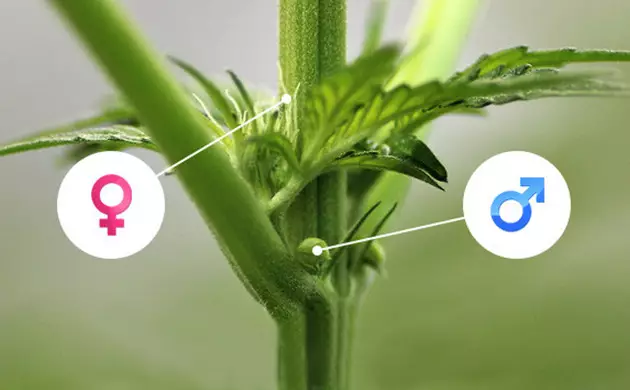
For indoor growing, stress may occur when temperatures get too high or when light leaks in at the wrong time, messing up with the light schedule. In case you’re aware of a reason for your cannabis plants to experience stress, start watching the nodes carefully. If you see that your female plants have started forming not only bracts, but also pollen sacs or anthers, you need to carefully remove all male body organs and continue doing so every couple of days until well into the flowering period (when you’re sure they won’t appear anymore).
The Final Word
To deem a growing season successful, we all want to harvest the large, sticky buds that we can smoke. For this, you need to have at least one female cannabis plant in your garden that’s protected from male pollen. We hope this article has helped you in discovering the differences between male and female weed plants. Use this knowledge to sex your plants on time and harvest a crop of bountiful buds. Happy growing!
Herbies Head Shop expressly refuses to support the use, production, or supply of illegal substances. For more details read our Legal Disclaimer.










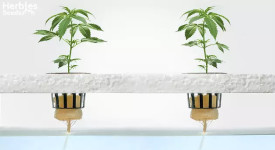

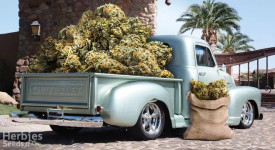
Thank you for leaving a comment for us!
Your feedback will be posted shortly after our moderator checks it.
Please note that we don’t publish reviews that: